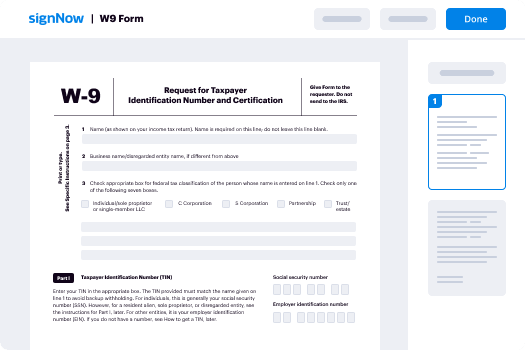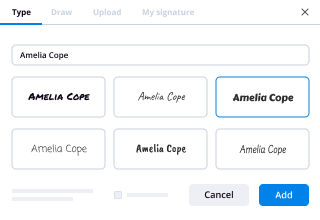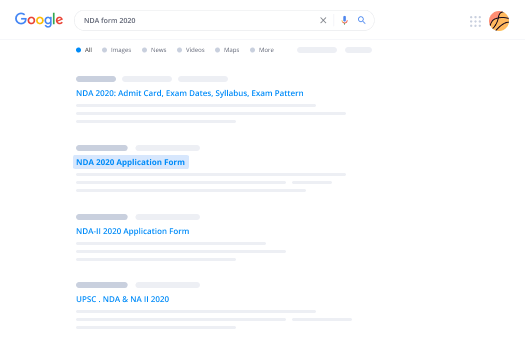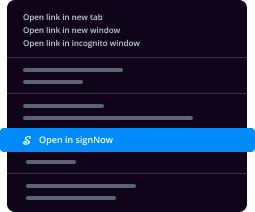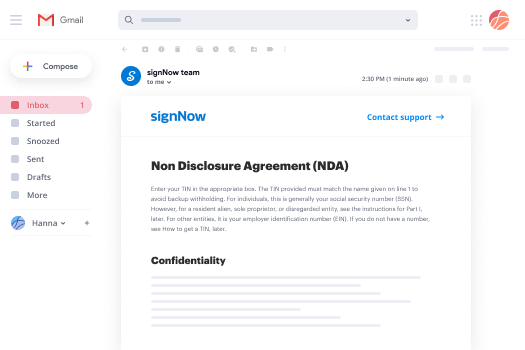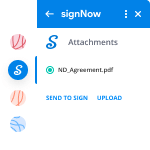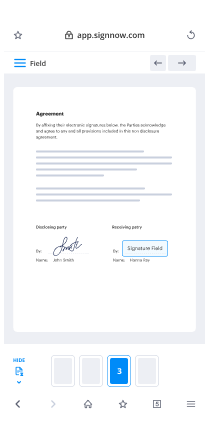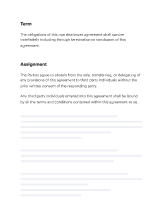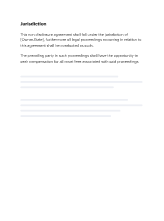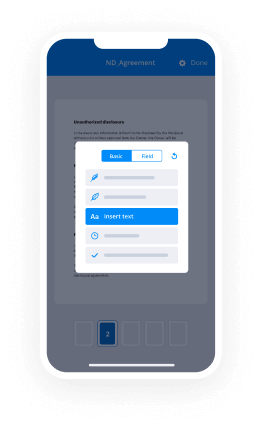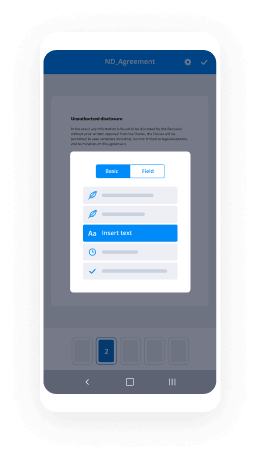Aumenta El Cumplimiento Con eSignatures: Firmas Electrónicas En Escrituras
- Rápido para iniciar
- Fácil de usar
- Soporte 24/7
Las empresas con visión de futuro de todo el mundo confían en SignNow






Acelera tus flujos de trabajo de documentos con eSignature de airSlate SignNow
Aprovecha las eSignatures válidas
Crea órdenes de firma
Usa eSignatures fuera de airSlate SignNow
Mejora tu trabajo en equipo
Firmas electrónicas en escrituras profesionalmente
Ahorra tiempo con enlaces compartibles
Guía rápida sobre cómo firmar electrónicamente en escrituras
Cada negocio necesita firmas, y cada negocio quiere mejorar el proceso de recopilarlas. Obtén una gestión de documentos precisa con airSlate SignNow. Puedes firmar electrónicamente en escrituras, crear plantillas rellenables, personalizar invitaciones de eSignature, enviar enlaces de firma, colaborar en equipos y mucho más. Descubre formas de simplificar la recopilación de firmas electrónicamente.
Sigue los siguientes pasos a continuación para firmar electrónicamente en escrituras en unos pocos minutos:
- Inicia tu navegador web y ve a signnow.com.
- Suscríbete para una prueba gratuita o inicia sesión utilizando tu correo electrónico o credenciales de Google/Facebook.
- Haz clic en Avatar de Usuario -> Mi Cuenta en la parte superior derecha de la página.
- Personaliza tu Perfil de Usuario con tus datos personales y configuraciones de cambio.
- Diseña y gestiona tu(s) Firma Predeterminada.
- Regresa a la página del panel de control.
- Pasa el cursor sobre el botón Subir y Crear y selecciona la opción necesaria.
- Haz clic en la opción Preparar y Enviar junto al nombre del documento.
- Escribe el nombre y la dirección de correo electrónico de todos los firmantes en la pantalla emergente que se abre.
- Utiliza el menú Comenzar a agregar campos para comenzar a modificar el documento y firmarlo tú mismo.
- Haz clic en GUARDAR E INVITAR cuando hayas terminado.
- Continúa personalizando tu flujo de trabajo de eSignature utilizando funciones adicionales.
No podría ser más fácil firmar electrónicamente en escrituras que eso. Además, puedes instalar la aplicación gratuita airSlate SignNow en tu teléfono móvil y acceder a tu perfil dondequiera que estés sin estar atado a tu computadora de escritorio o lugar de trabajo. Ve sin papel y comienza a firmar contratos en línea.
Cómo funciona
Califica tu experiencia
What is the electronic signatures on deeds
Electronic signatures on deeds refer to the digital method of signing legal documents that transfer ownership or rights, such as property deeds. This process allows individuals and businesses to execute documents electronically, ensuring a secure and efficient transaction. By utilizing eSignatures, parties can validate their agreements without the need for physical paperwork, streamlining the entire process.
How to use the electronic signatures on deeds
To use electronic signatures on deeds, start by preparing the deed document in a compatible format. Upload the document to airSlate SignNow, where you can easily add signature fields. You can then send the document for signature to the relevant parties via email. Recipients will receive a notification, allowing them to review and eSign the document securely. Once all signatures are collected, the completed deed can be downloaded or stored in the airSlate SignNow cloud for future reference.
Steps to complete the electronic signatures on deeds
Completing electronic signatures on deeds involves several straightforward steps:
- Prepare the deed document in a digital format.
- Log into your airSlate SignNow account and upload the document.
- Add signature fields for each signer as necessary.
- Send the document for signature by entering the email addresses of the signers.
- Each signer reviews the document and applies their electronic signature.
- Once all parties have signed, download the fully executed deed for your records.
Legal use of the electronic signatures on deeds
In the United States, electronic signatures on deeds are legally recognized under the Electronic Signatures in Global and National Commerce (ESIGN) Act and the Uniform Electronic Transactions Act (UETA). These laws affirm that eSignatures hold the same legal weight as traditional handwritten signatures, provided that all parties consent to use electronic means for signing. This legal framework ensures that electronic signatures can be used effectively in real estate transactions and other legal agreements.
Key elements of the electronic signatures on deeds
When using electronic signatures on deeds, several key elements must be considered to ensure validity:
- Intent to Sign: All parties must demonstrate their intention to sign the document electronically.
- Consent: Parties should agree to use electronic signatures, which can be documented within the deed.
- Authentication: The identity of signers must be verified to prevent fraud.
- Record Retention: A copy of the signed deed must be stored securely for future reference.
State-specific rules for the electronic signatures on deeds
While electronic signatures are generally accepted across the United States, some states have specific rules regarding their use on deeds. It is crucial to review state laws to ensure compliance. For instance, certain jurisdictions may require additional verification steps or have specific formatting requirements for electronic deeds. Understanding these nuances helps ensure that your electronic signatures are valid and enforceable.
¡Obtenga ahora firmas vinculantes desde el punto de vista jurídico!
-
Mejor ROI. Nuestros clientes logran un promedio de 7x ROI en los primeros seis meses.
-
Se adapta a sus casos de uso. De las PYMES al mercado medio, airSlate SignNow ofrece resultados para empresas de todos los tamaños.
-
Interfaz de usuario intuitiva y API. Firma y envía documentos desde tus aplicaciones en minutos.
Firma en línea FAQs
-
What are electronic signatures on deeds?
Electronic signatures on deeds are digital representations of a person's intent to sign a document, specifically legal deeds. They provide a secure and efficient way to execute documents without the need for physical signatures, ensuring compliance with legal standards. -
How does airSlate SignNow facilitate electronic signatures on deeds?
airSlate SignNow offers a user-friendly platform that allows businesses to easily send and manage electronic signatures on deeds. With features like customizable templates and secure storage, users can streamline their signing process while maintaining legal validity. -
Are electronic signatures on deeds legally binding?
Yes, electronic signatures on deeds are legally binding in many jurisdictions, provided they meet specific criteria. airSlate SignNow ensures compliance with relevant laws, making it a reliable choice for executing legal documents. -
What pricing options does airSlate SignNow offer for electronic signatures on deeds?
airSlate SignNow provides flexible pricing plans tailored to different business needs. Whether you are a small business or a large enterprise, you can find a cost-effective solution for managing electronic signatures on deeds. -
What features does airSlate SignNow include for electronic signatures on deeds?
airSlate SignNow includes features such as document templates, real-time tracking, and secure cloud storage, all designed to enhance the process of obtaining electronic signatures on deeds. These tools help streamline workflows and improve efficiency. -
Can I integrate airSlate SignNow with other software for electronic signatures on deeds?
Yes, airSlate SignNow offers integrations with various software applications, allowing you to seamlessly incorporate electronic signatures on deeds into your existing workflows. This enhances productivity and ensures a smooth signing experience. -
What are the benefits of using electronic signatures on deeds?
Using electronic signatures on deeds offers numerous benefits, including faster turnaround times, reduced paper usage, and enhanced security. airSlate SignNow helps businesses save time and resources while ensuring the integrity of their documents.




















